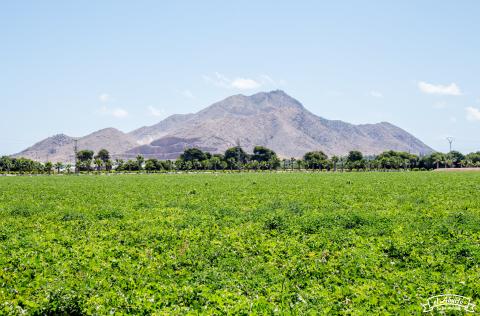The 2017 SAN Standard sets to curb deforestation and promote climate-smart agriculture
The Sustainable Agriculture Network (SAN) and the Rainforest Alliance (RA) have recently launched a revised agriculture certification standard. The Standard raises the bar on sustainability standards with a focus on tackling deforestation, climate-smart agriculture and continuous farm improvements.
 The revised Standard incorporates existing best practices and recent innovations in sustainable agriculture. It aims to provide guiding principles so farmers can improve their livelihood and farm productivity as well as increase their own capacity to cope with climate change.
The revised Standard incorporates existing best practices and recent innovations in sustainable agriculture. It aims to provide guiding principles so farmers can improve their livelihood and farm productivity as well as increase their own capacity to cope with climate change.
During the last sixteen years, SAN and the Rainforest Alliance have certified more than one million small, medium and large farms and farming cooperatives worldwide. The 2017 SAN Standard now seeks to enable more producers to embark and then continuously progress on the journey towards sustainable farming.
“Among others, a notable improvement is an expanded and carefully selected set of Critical Criteria, which farms have to fully comply with before being granted the certificate,” said Hando Hain, NEPCon Programme Director and member of the SAN Board of Directors.
“The new SAN Standard is a result of over three years of dedicated work and intensive consultation. It builds on the extensive SAN and the Rainforest Alliance’s certification experience from the past two decades,” added Mr Hain.
 Protecting the world forest
Protecting the world forest
Agriculture has been one of the main drivers of deforestation particularly in tropical areas. A key goal of the 2017 SAN Standard therefore is to reduce forest conversion for agriculture purposes.
This new Standard seeks to strengthen the protection of forests and ecosystems, which has been previously set under SAN and the Rainforest Alliance certification requirements.
Regarding destruction of the High Conservation Value (HCV) areas, there is a cut-off date as of November 2005. Any destruction of HCV areas after this date means the farm is not eligible for SAN certification.
There are also further requirements for protection of all natural ecosystems and forests at least within the five year period prior to initial certification with an additional cut-off date of January 2014.
The 2017 SAN Standard also requires farms to implement a planning cycle in which a proportion of the certified farmland needs to be under native vegetation. This includes large native trees, zones adjacent to water bodies, and shade trees cover on production plots. Such native vegetation has been widely known to play important roles in maintaining critical ecosystem services such as pollination, pest control and water purification.
Climate resilience
To help farmers address climate change risks, this revised Standard encompasses climate-smart agricultural practices.
Farmers can reduce negative effects of extreme or erratic weather such as irregular rainfall or related increased pest attacks by focusing on techniques that help conserve soil or use water in a more efficient ways for example. Similar practices also help reduce greenhouse gas emissions from agriculture.
Making responsible agriculture more accessible
Considering sustainability is not a destination but a path and a process over time, SAN and the Rainforest Alliance have designed this new Standard to walk the farms along a path of continuous improvements.
The new Standard has significantly further improved the ‘Continuous Improvement Framework’. It contains Critical Criteria and three levels of Continuous Improvement Criteria (C, B and A), defining four stages of performance across fourteen areas of mandatory improvements on water quality, waste management, soil conservation, working conditions and living wages for example.

After achieving full compliance with the Critical Criteria, farms need to progressively attain three sustainability levels within their first six years. For instance, farms need to reach the middle level performance by year three and the top level by year six. This approach makes it more accessible for many farmers who are still in the early steps or those who are new to the Standard and want to engage in this certification scheme. At the same time, it requires farms to strictly commit on time-bound investment and improvements.
“With various levels of requirements and associated compliance thresholds, the new Standard drives improvements across every Standard criteria, while enabling larger pool of farmers to start and improve on their journey towards sustainability,” explained Mr Hain.
Higher ambition to cover human rights and production issues
The new Standard sets out stricter social and labour requirements to further protect workers’ rights and improve the livelihoods of workers and their families. Farms for example are required to implement rigorous gender and child labour protections. In addition they need to have efficient ways for employees to make complaints and file grievances.
By including specific risk mitigation criteria for pesticides, the 2017 SAN Standard is so far the first voluntary certification standard with such detailed and methodological approach in relation to pesticides. Accordingly, risks will be classified to different levels such as inhalation risks to workers and bystanders or risk to aquatic life, wildlife and pollinators.
When will the new rules be applicable?
2017 SAN Standard will come into force on 1 July 2017. Accordingly, all audits taking place from this time onwards will be based on the new Standard.
For current certificate holders, SAN has defined a transition process according to the date of the last certification audit with the 2010/11 SAN Standard. Existing certified farms then will be audited against the new standard between July 2017 and December 2018.
> View the Standard and check out resources you need to unfold the 2017 SAN Standard



